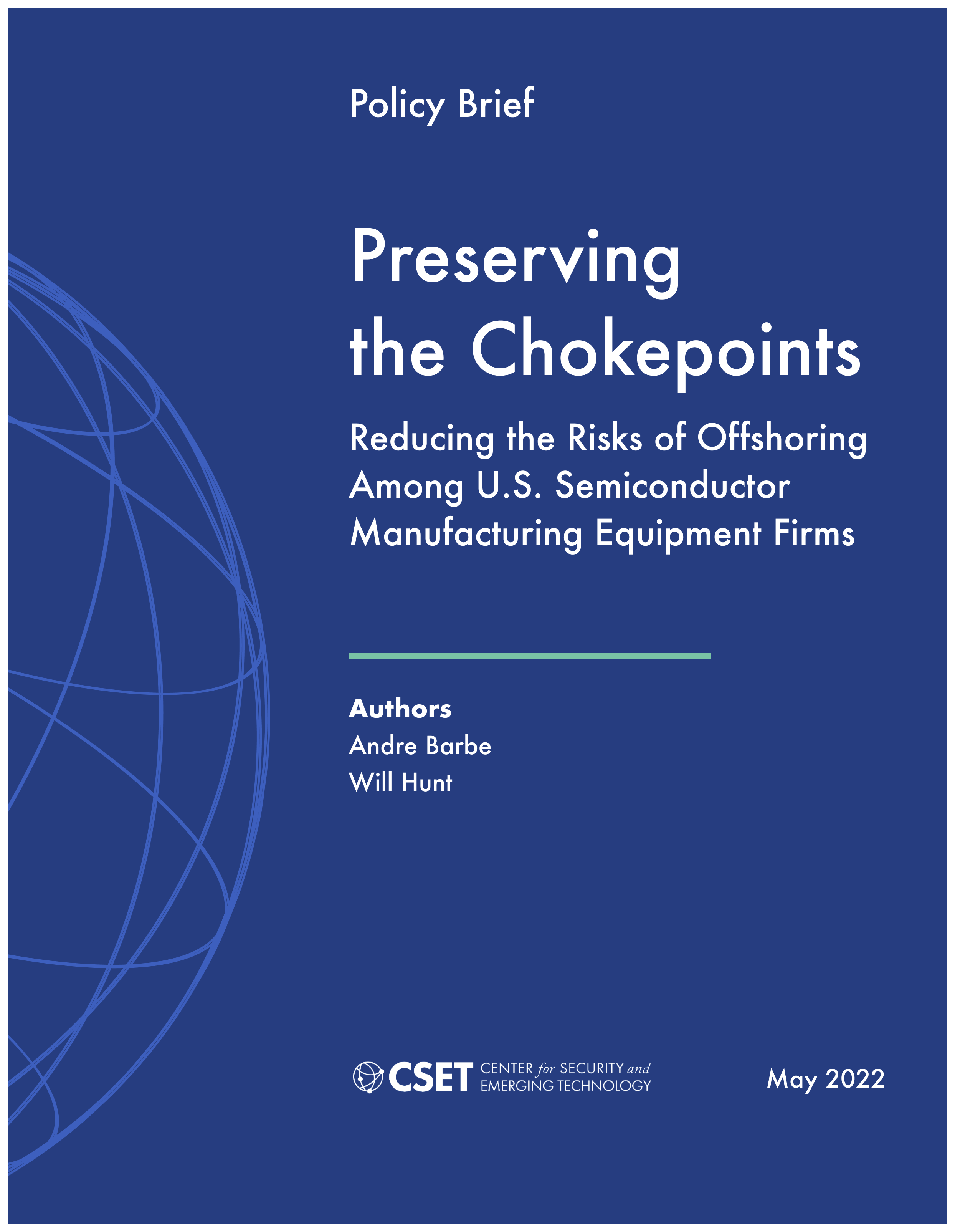Introduction
China can produce many types of computer chips, but it depends on companies headquartered in the United States and U.S. allies for the leading-edge computer chips that power smartphones, supercomputers, and artificial intelligence systems. China’s chip dependence allows the United States and its allies to cut off the supply of chips to Chinese state or private actors that threaten human rights or international security.
Export controls on advanced semiconductor manufacturing equipment (SME) are among the most important tools available to sustain China’s chip dependence. The production of advanced SME is dominated by a handful of firms in the United States, Japan, and the Netherlands, and the technology is highly complex, such that competitors face steep challenges to developing advanced SME.1 For example, EUV photolithography equipment is essential for manufacturing leading-edge logic chips, but it is sold by just one company: the Dutch firm ASML.2 The United States and its allies have used export controls on SME to prevent China from indigenizing advanced chipmaking capabilities, thereby sustaining China’s dependence on democracies for access to leading-edge chips.3 Since 2019, U.S. export controls on SME have also prevented chipmakers in other countries from selling chips to the Chinese telecommunications giant Huawei.4 More recently, the United States and its allies have implemented similar rules to restrict sales of chips and a variety of electronic equipment to Russia and Russian military end users.5
But export controls can also have adverse long-term effects if they incentivize U.S. SME firms themselves to offshore production to other countries. Recent unilateral U.S. export controls targeting China—which is now the world’s largest market for SME firms6—have raised concerns that U.S. SME firms might relocate production abroad to avoid future tariffs or export controls. Offshoring of SME production would both remove an important source of leverage over China and make the United States more dependent on other countries for access to some of the most important inputs to semiconductor manufacturing. This brief explores the degree to which U.S. SME firms are offshoring their production to other countries and the reasons driving firms to offshore.
Findings:
- Top SME firms maintain and are building/investing in offshore manufacturing capacity. Of the top three U.S. SME firms, Applied Materials states that half of its manufacturing occurs in Singapore, and both KLA and Lam Research have made significant investments in manufacturing facilities overseas. However, the United States, Japan, and the Netherlands collectively continue to produce a majority of global SME exports onshore.
- U.S. SME firms engage in offshore manufacturing for many reasons that predate recent export controls. These include foreign acquisitions, greater proximity to customers in East Asia, and access to new STEM talent. However, SME firms are closely tracking developments in U.S. export control policy, particularly the use of the foreign-produced direct product rule (FDPR) and similar extraterritorial controls. Most U.S. SME firms have experienced limited business impacts from export controls thus far but discuss export controls as a risk in their annual reports.
Recommendations:
- Establish a new multilateral regime for controlling SME exports. Multilateral controls significantly reduce the risks of offshoring, but the Wassenaar Arrangement—currently the primary regime for coordinating multilateral export controls on SME—is too large and unwieldy for this purpose. Fortunately, the United States, Japan, and a handful of other allies are currently discussing the establishment of a new regime for controlling SME and other advanced technologies.7 Such a regime is urgently needed.
- Avoid unilateral export controls on SME. Conventional unilateral controls typically will not prevent U.S. firms from shipping SME to China from their overseas manufacturing sites. Extraterritorial controls like the FDPR can prevent this in the short run, but such controls create incentives to design out U.S.-origin technologies over the long run.
- Fund the CHIPS for America Act. Historically, proximity to chipmakers in East Asia—SME firms’ largest customers—has been a key motivator of offshore manufacturing among SME firms. Reshoring chipmaking capacity to the United States could therefore indirectly draw SME firms to produce more in the United States.
- Promote onshore SME production through workforce investments, high-skilled immigration, and direct incentives. Congress should pass the green card cap exemption for PhD holders in certain STEM fields, as stipulated in the America COMPETES Act of 2022. Congress should also consider tax credits for SME firms, such as those in the Facilitating American-Built Semiconductors (FABS) Act and the Advanced Manufacturing Investment Credit (AMIC) included in the House-passed Build Back Better Act.
Download Full Report
Preserving the Chokepoints- Will Hunt, Saif M. Khan, and Dahlia Peterson, “China’s Progress in Semiconductor Manufacturing Equipment” (Center for Security and Emerging Technology, March 2021), https://cset.georgetown.edu/publication/chinas-progress-in-semiconductor-manufacturing-equipment/.
- Saif M. Khan and Carrick Flynn, “Maintaining China’s Dependence on Democracies for Advanced Computer Chips” (The Brookings Institution, April 2020), https://www.brookings.edu/wp-content/uploads/2020/04/FP_20200427_computer_chips_khan_flynn.pdf.
- Saif M. Khan, “Securing Semiconductor Supply Chains” (Center for Security and Emerging Technology, January 2021), https://cset.georgetown.edu/publication/securing-semiconductor-supply-chains/.
- “BIS Publishes Final ‘Direct Product’ Rule for Huawei and Entity List Compliance Obligation Clarifications,” Crowell, August 21, 2020, https://www.crowell.com/NewsEvents/AlertsNewsletters/all/BIS-Publishes-Final-Direct-Product-Rule-for-Huawei-and-Entity-List-Compliance-Obligation-Clarifications.
- Bureau of Industry and Security, “Implementation of Sanctions Against Russia Under the Export Administration Regulations (EAR),” U.S. Department of Commerce, 87 FR 12226, https://www.federalregister.gov/documents/2022/03/03/2022-04300/implementation-of-sanctions-against-russia-under-the-export-administration-regulations-ear.
- Che Pan, “US-China tech war: China becomes world’s top semiconductor equipment market as Beijing pushes local chip industry,” South China Morning Post, April 15, 2021, https://www.scmp.com/tech/tech-trends/article/3129611/us-china-tech-war-china-becomes-worlds-top-semiconductor-equipment.
- Amanda Lee, “US-Japan alliance restricting vital tech exports to China risks ‘major impact’ on trade, supply chains,” South China Morning Post, January 25, 2022, https://www.scmp.com/economy/china-economy/article/3164537/us-japan-alliance-restricting-vital-tech-exports-china-risks.
